Historic Nottingham - Part 10 - Castle Gate (West)
w/e 20 January 2008
All this week's pictures were taken
with a Kodak DX6490
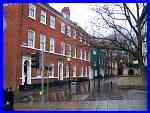 We
pick up our walk about half way along Castle Gate near to its
junction with Maid Marian Way. Our route in this, the final part
is to cross the dual carriageway and continue along the western
end of Castle Gate (left) to end at Nottingham Castle. There
are of course many other historic buildings to be seen in and
around the city centre but this series has been following the
route as described in Malcolm Sales' book "100 Walks In
Nottinghamshire" and images of other areas will have to
wait for another time - especially as the images on this page
were captured in the pouring rain. Apologies again, as in Part
9 if any raindrops show up on the lens. We
pick up our walk about half way along Castle Gate near to its
junction with Maid Marian Way. Our route in this, the final part
is to cross the dual carriageway and continue along the western
end of Castle Gate (left) to end at Nottingham Castle. There
are of course many other historic buildings to be seen in and
around the city centre but this series has been following the
route as described in Malcolm Sales' book "100 Walks In
Nottinghamshire" and images of other areas will have to
wait for another time - especially as the images on this page
were captured in the pouring rain. Apologies again, as in Part
9 if any raindrops show up on the lens.
Unfortunately not all of the twentieth century development in
Nottingham has been sympathetic to the history of the area and
many of the older buildings are now dwarfed by the concrete,
brick and glass of high rise blocks.
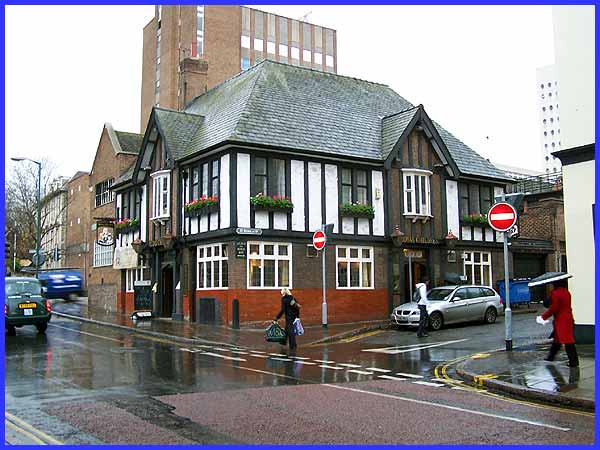
 The
Royal Children inn however did acknowledge its history when it
was erected in 1933 on the site of the old inn not only being
built in a style more in keeping with the area but also retaining
the curious name. It stems from the children of Princess Anne,
daughter of James II. When his throne was under threat in 1688,
Anne sought refuge in Nottingham Castle where she was well received
by the local populace and it is said that her children were accommodated The
Royal Children inn however did acknowledge its history when it
was erected in 1933 on the site of the old inn not only being
built in a style more in keeping with the area but also retaining
the curious name. It stems from the children of Princess Anne,
daughter of James II. When his throne was under threat in 1688,
Anne sought refuge in Nottingham Castle where she was well received
by the local populace and it is said that her children were accommodated
 at the inn. The
inn sign today incorporates representations of the children but
at one time the name was displayed on the shoulder-blade of a
whale that was used as the inn sign. The ravages of time and
weather caused deterioration to the whalebone and it is now on
display inside the inn. As to why a place that is just about
as far as you can get from the coast in England should be associated
with a whalebone is easily answered. Whale oil used to be as
common as paraffin became later and whaling skippers from the
north-east ports such as Whitby distributed various skeletal
remains as advertisements. at the inn. The
inn sign today incorporates representations of the children but
at one time the name was displayed on the shoulder-blade of a
whale that was used as the inn sign. The ravages of time and
weather caused deterioration to the whalebone and it is now on
display inside the inn. As to why a place that is just about
as far as you can get from the coast in England should be associated
with a whalebone is easily answered. Whale oil used to be as
common as paraffin became later and whaling skippers from the
north-east ports such as Whitby distributed various skeletal
remains as advertisements.
|
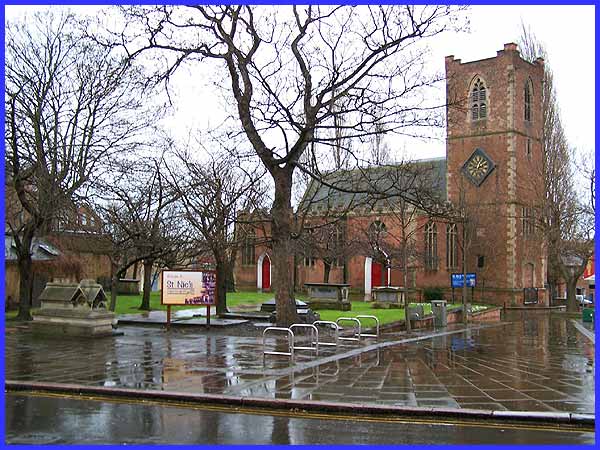
Across from the Royal Children is what appears in this image
to be the relative calm of St Nicholas' Church or as it is popularly
known St Nic's. Appearances can be deceiving however as Maid
Marian Way is at the extreme right of the image and traffic passes
by constantly. The present church was built between 1671 and
1682 on the site of a mediaeval one dating from 1141 that suffered
demolition during the Civil War on the orders of Colonel John
Hutchinson. The story is this: King Charles I raised his standard
in Nottingham on 22nd August 1642 calling his sponsors to arms,
an act that started the Civil War. He found little local support
and Nottingham Castle was garrisoned by Parliamentarians led
by Col. Hutchinson. They often came under attack by Royalist
forces based in nearby Newark and one significant attack took
place in September 1643 when they came under fire from the tower
of St Nic's during a three day period when the Royalists actually
held the town. When the Parliamentarians regained control, the
orders came to demolish the church.
|
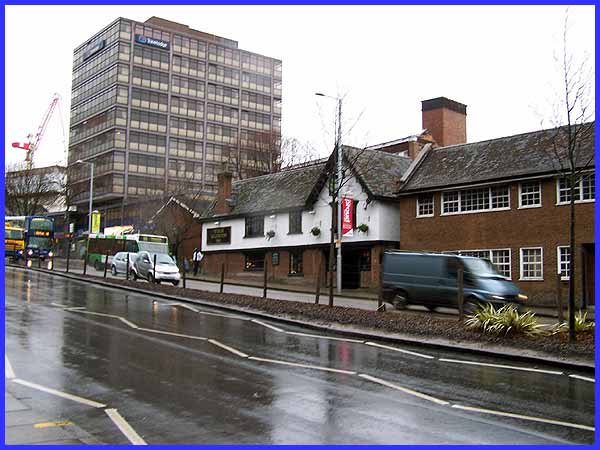
St Nic's lies to the south of Castle Gate at its junction with
Maid Marian Way and to the north is another pub that lays claim
to being one of the oldest in Nottingham, the others being the
Bell Inn and the Trip To Jerusalem. This one is Ye Olde Salutation
Inn or again as it it more popularly known The Sal. A board on
the wall fronting onto the dual carriageway reads: “The
present house was built c. 1240 on the site of the 13th  century Ale
House known as ‘The Archangel Gabriel Salutes the Virgin
Mary.’ During the first Civil War 1642-1646 part of the
house was used as Recruiting Rooms for both Factions. The original
still existing Cave System was probably Saxon Farm, later used
for Servants Accommodation and Brewing”. The name of the
inn, like its neighbour The Royal Children is rather curious.
It refers to the salutation "Ave Maria, plene gratia,"
given by the Archangel Gabriel to the Blessed Virgin as noted
on the information board and as this was associated with inns
belonging to religious houses, it is possible that The Sal may
have been associated with either the Carmelite or the Franciscan
friary of Nottingham. century Ale
House known as ‘The Archangel Gabriel Salutes the Virgin
Mary.’ During the first Civil War 1642-1646 part of the
house was used as Recruiting Rooms for both Factions. The original
still existing Cave System was probably Saxon Farm, later used
for Servants Accommodation and Brewing”. The name of the
inn, like its neighbour The Royal Children is rather curious.
It refers to the salutation "Ave Maria, plene gratia,"
given by the Archangel Gabriel to the Blessed Virgin as noted
on the information board and as this was associated with inns
belonging to religious houses, it is possible that The Sal may
have been associated with either the Carmelite or the Franciscan
friary of Nottingham.
|
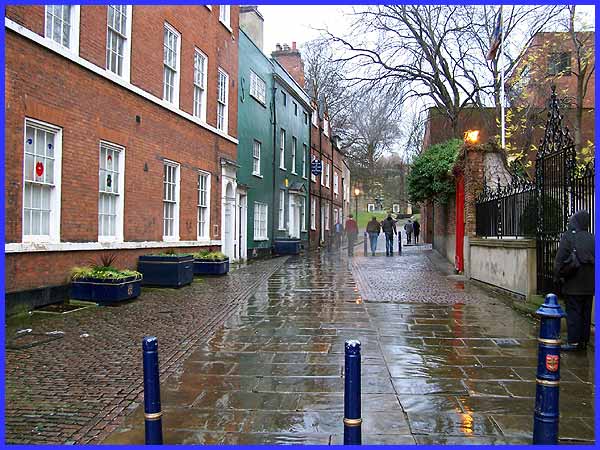
As we turn back into the western end of Castle Gate the contrast
with the busy road and high rise building seen in the previous
image could hardly be more stark. In its day however Castle Gate
was probably the Maid Marian Way of its time housing many of
the wealthiest citizens of the town from the Middle Ages into
the nineteenth century. The word "gate" as in Castle
Gate and a dozen or so other streets in the city is of Scandinavian
origin and meant "thoroughfare" rather than today's
meaning of "barrier". From the left in the picture
above, the brick building dates from 1788; the green one is also
an eighteenth century structure and until recently housed a Costume
Museum; then follows a building from about 1688 with more seventeenth
century buildings at the far end. On the right fronting Newdigate
House, are the iron railings thought to be by Francis Foulgham
who worked in Nottingham from about 1710 until his death in 1749.
|
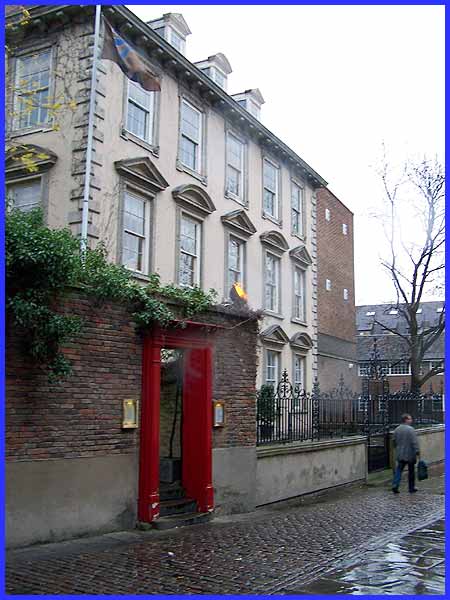
This view gives a better view of those railings and also the
house of 1675, built and named after the Newdigate family which
was occupied by Marshall Tallard between 1705 and 1711. Marshall
Tallard was commander of the French Army at the Battle of Blenheim
in 1714 and lived in Nottingham on parole after being captured
in 1704 by the English general, the Duke of Marlborough. It was
Marshall Tallard that tradition records as being responsible
for teaching the people of Nottingham to bake French (white)
bread and for introducing celery to England. He was familiar
with the plant in his native country and when he found it growing
wild in the Lenton marshes, he cultivated it in his garden at
Newdigate House.
|

And so we reach the end of our walk back at the castle. Robin
Hood is still aiming his arrow at the ramparts but since our
initial view in this vicinity back in Part 1 the weather has
changed and the rain is now teeming down. On another occasion
I might have been tempted inside the castle gates but as it was
getting more and more difficult to keep the deluge off the camera,
I decided to call it a day and leave that for another time. If
this has whetted (or given these damp conditions, should that
be wetted?) your appetite you could always revisit this page from when we visited the castle
grounds in September 2004.
Since beginning this series following a walk through Historic
Nottingham, I have discovered a similar exercise has been undertaken
for the BBC site for Nottingham. Their route starts and finishes
at a different place but covers circular path so for a slightly
different perspective of "The town that Snot built"
you can see the BBC feature in a new window by clicking here.
|

